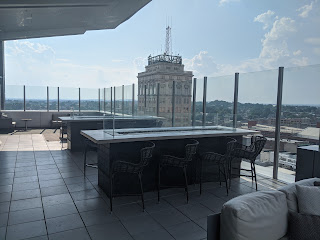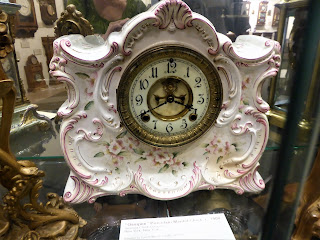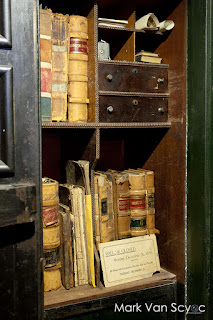It's been some time since I've updated this blog, which is a shame, but COVID-19, not to mention civil unrest, has put a damper on everything and that includes travel. Last month, my husband and I decided to revisit Berkeley Springs West Virginia--a place I hadn't been to since my infamous water tasting, which is referenced in an earlier post
here. If you've never been to that part of West Virginia, it's quite cute and I didn't have to hear about COVID everywhere I went. I blogged about the area, which you can read about by clicking
here. We were welcomed warmly and thoroughly enjoyed our stay, but enough about West Virginia, I'm here to share a few details about some of the smaller towns located within a short driving distance of New Holland in Pennsylvania's Lancaster County.
 |
| Horses and buggies are common transportation in Lancaster County. |
Last week we moved into a cute little rancher located on Ranck Road in New Holland. The house we rented through VRBO (Vacation Rentals by Owner) served as our base camp for four nights and served up a little slice of what it would be like to live in the area. The drawbacks? Well, first of all, we discovered that the living room lacked air conditioning--literally not cool when the days temps soared into the upper 90's. We also learned that in order to keep a cell phone signal we had to trudge the length of the front yard and stand near the street. We also discovered that the place lacked a television, which was quite a surprise. I'm glad I toted along my bag full of periodicals and an interesting tome written by Bill Bryson titled, "At Home: A Short History of Private Life," which I highly recommend, by the way.
Additional distractions included an adjacent horse farm, beautiful landscaping throughout the property and several friendly neighborhood cats.
 |
| The yellow flowers helped us spot where to turn into our driveway. |
 |
| Pretty pink lilies bloom on the property. |
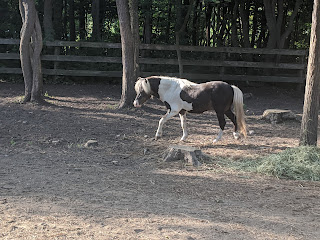 |
| The friendly horses included two miniature ponies. |
 |
This guy had a gum problem, according to the owners, who assured
us that he still eats very well. |
 |
| This cute cat reminds me of a long haired cat I used to own. |
 |
| The horses came up to the fence to greet us. |
Even though I could have spent time there working on articles, I thought it better to clear the decks so I didn't have a thing to do but a bit of sightseeing and, of course, some reading.
Each day we spent some time driving through neighboring towns, past bucolic farms, through dappled woodlands, and over rolling hills, while encountering the occasional horse and buggy. If you've ever visited Lancaster County, you'll understand how this alone is a beautiful experience.
During our stay, we learned more about the Amish, spent some time poking around food and book stores, visited boutique shops and purchased some unusual plants at an Amish greenhouse chock full of bargains.
In this area of Lancaster County, visitors will encounter a mix of business owners, from Mennonites, to Amish and of course, "Englishers," or non-Amish.
First Stop Kitchen Kettle Village
If you like to browse small shops featuring unique items, you'll find Kitchen Kettle Village in the heart of the small town of Intercourse. The Village is a third-generation family business that is comprised of 40 shops, restaurants and lodging.
 |
| The Inn at Kitchen Kettle Village is conveniently surrounded by shops and restaurants. |
The Inn at Kitchen Kettle Village is a three-star hotel which enables tourists to stay in the heart of the action. It is comprised of seven one-and-two bedroom suites and 11 guestrooms.
The Gift House, located in the foreground of the picture, carries a large selection of gifts, from jewelry, to souvenirs, soaps and home decor.
Other businesses sell everything from jellies and jams, to quilts, candles, leather, furniture and baked goods.
 |
| The Country Life shop sells primitive country accents and locally made furniture. |
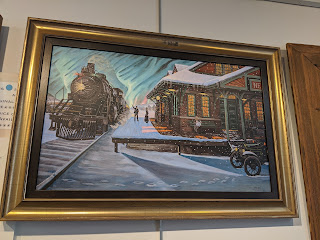 |
| Dutchland Galleries represents local and regional artists. |
 |
| Hot sauces with humorous names can be found at The Aged and Cured Cheese & Meat Shoppe. |
 |
| The Olive Basin offers premium olive oils and balsamic vinegars. |
 |
| Brighton Collectibles features leather purses, shoes and a nice selection of jewelry. |
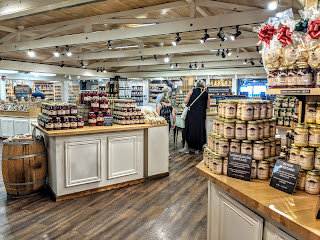 |
| The Jam & Relish Kitchen carries a large selection of jams, jellies, mustard and more. |
Additional Shopping Opportunities
If you like books, you'll find a number of independent bookstores in Lancaster County, such as the
Gordonville Book Store where you can find Amish cookbooks, fiction and non-fiction books, games and toys and homeschooling materials. As a tutor, I sometimes have a difficult time finding workbooks and other supplies, so I was glad to stumble on this place, along with the Clay Book Store in Ephrata, which carries much the same.
If you like plants, you'll get a bargain at
Town's Edge Greenhouse. I purchased these succulents for mere $4.99 each and the English ivy for $1.99.
 |
| Succulents sold at a good price at Town's Edge Greenhouse. |
 |
| This plant is known as a "Propeller plant" and is endemic to South Africa, so I hope I don't kill it. |
The Amish Farm and House
When you pull up to the parking lot of the local Target and see
The Amish Farm and House, it's a bit confusing and anachronistic until you learn during the tour that the House was there first and the Amish Farm and House was the first Amish attraction in the United States. The attraction is open seven days a week; house tours are held throughout the day and last a total of 30 minutes.
During the tour, visitors are ushered through the living room and kitchen of the 1805 farmhouse and then led upstairs to see how the family lived. Our guide Dale said that he'd been working there for 52 years. "I figured it was easier than farm work," he said,with a chuckle.
Visitors on the tour will learn that the land on which the house sits was deeded by Thomas Penn (son of William Penn) to John Evans, who served as Governor of Pennsylvania in the early 1700's. In later years, the house and farm was run by an Amish family who worked as tenant farmers.
 |
| The kitchen at the Amish Farm and House. |
 |
| This stove likely saw a lot of activity back in the day. |
 |
| Upstairs at the Amish Farm and House. |
Guests will learn many other interesting things about the Amish during the house tour, including how their numbers grew from only 18 original families to 350,000 people today, with 40,000 Amish in Lancaster alone. Today you can find Amish in 31 states and four provinces of Canada, but none on our nation's West Coast.
Included in the price of the house tour is a self-guided farm tour where visitors will see a summer kitchen, a blacksmith shop, a tobacco shed, a bake oven, a smokehouse, a lime kiln, a spring house, a "
cucumber pump" and more. Cows, chickens, peacocks and goats are of particular interest to the younger visitors.
 |
"Der Bock Offe." The Bake Oven was removed from a mid-eighteenth century house near Christiana and is approximately 250 years old. It's estimated that fewer than a dozen exist in Lancaster County.
|
 |
| Tobacco dries in the drying house. |
 |
| A play area is also a hit with the young visitors. |
 |
| Goats relax on a warm summer day. |
 |
| A cow stands in the water to cool off. |
 |
| Visitor Craig Nye relaxes on a cow bench. |
If you sign up for the Farm and House tour, followed by the self-guided farm tour, my recommendation is that you set aside one to 1.5 hours to see everything, including the Willow Lane One-Room Schoolhouse, also located on the farm.
 |
| The Willow Lane One-Room Schoolhouse. |
The Willow Lane One-Room Schoolhouse is Lancaster County's only one-room school house opened specifically to the public. Inside visitors will see a working gas stove, gas lights, Amish artwork completed by local Amish children, games, posters and more.
Before leaving, don't forget to check out the unique items in the gift shop like this one below.
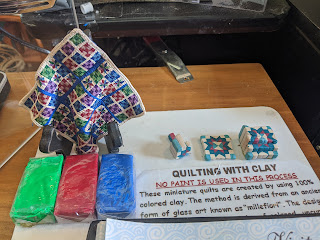 |
| An Amish "quilt" crafted of clay. |
Good Eats
 |
| The exterior of the Revere Tavern on a rainy evening. |
If you enjoy history and delicious food, you'll love the historic
Revere Tavern in Paradise. The Revere Tavern dates back to 1740 and was formerly known as the "Sign of the Spread Eagle" and was a "Stage Tavern." According to the owners, it was one of the better inns along the 62 miles of turnpike stretching from Philadelphia to Lancaster and therefore catered to the more prosperous class of travelers with fine spirits and hearty food.
Almost a century later, the tavern would become the residence of Reverend Edward V. Buchanan and his wife Eliza Foster Buchanan, sister of
Stephen Foster who was known as the "Father of American Music" and wrote such familiar refrains as "My Olde Kentucky Home" and "Oh Susanna."
 |
| A plaque mounted inside of the Revere Tavern. |
Over the years, my husband and I have visited their bar for a drink while in town, but we never took the time to dine in the tavern until this visit. After tasting the delicious food, we were kicking ourselves for not doing it sooner.
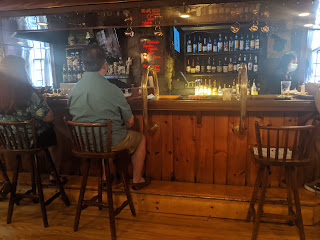 |
| The old bar at the Revere Tavern. |
 |
| The steak and asparagus far exceeded expectations..perfection. |
 |
| During the winter, the fireplace is employed. |
Another dining place I can highly recommend is
The Greenfield Restaurant and Bar in Lancaster.
 |
| The exterior of The Greenfield Restaurant and Bar. |
 |
| Flowers bloom out front. |
 |
| The Bar at the Greenfield Restaurant and Bar. |
 |
| Shrimp served at the Greenfield Restaurant and Bar. |
 |
| The Farmer's Market salad topped with a champagne vinaigrette and an over-easy egg. |
The upscale eatery is housed in the former farm home of the Clymer family. Chef John Moeller once worked at the White House and turns out perennial favorites like crab cakes, steaks, chicken, pork chops, lobster and more. A friend of mine who lives in the area said that the restaurant has a fantastic reputation of turning out consistently good food and I was happy to have the opportunity to experience it.
A Rooftop Bar in Lancaster
One of the newest destinations in Lancaster County is
The Exchange. When I decided to visit downtown Lancaster, this is the first place I wanted to go and was relieved to find them open since you never know when it comes to closings and COVID.
We arrived too early to witness the place in all its splendor, from the huge light fixture that must look spectacular at night, to the fire tables that are lit at dusk.
 |
| I would have loved to have seen this incredible light fixture lit up at night. |
 |
| Cozy seating everywhere. |
 |
| Not a bad view. |
We each enjoyed a craft cocktail before making our way to our next reservation, but we do hope to return to try the food made by Chef Ryan McQuillan. McQuillan made a name for himself having worked under George Perrier at Philly's Le Bec Fin and having served as head chef at Kennett Square's Talula's Table. McQuillan creates casual fare for The Exchange using fresh ingredients that celebrate Lancaster's bounty.
That's All for Now
I'm glad to, once again, be documenting some of my excursions and hope to post another blog in a few weeks when I visit another area where the pace of life is slow and easy. I hope to report back on my next trip to Salisbury Maryland in a few weeks and am anticipating that I will once again return home relaxed and recharged, which is just as it should be.














































